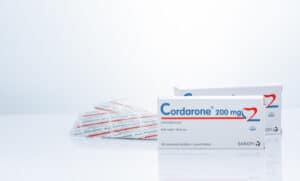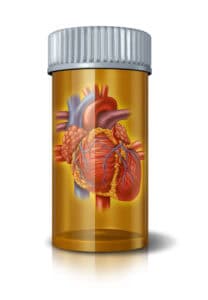When you’re desperate, you’ll do anything. If there are no other medical treatments to save your life, your child’s life, or your loved one’s life, you’ll take whatever solution you can get. It literally does not matter what the side effects are.
That’s essentially what the Food and Drug Administration (FDA) thought when it came time to approve a drug known as Amiodarone. Also known as Cordarone, Nexterone, or Pacerone, Amiodarone is a powerful drug used to control irregular heartbeat. The side effects of Amiodarone were serious. More serious, though, was the near-certainty of death from heart failure without these medications. That’s why the FDA gave Amiodarone its stamp of approval.
That’s not where the story ends, though. Amiodarone may have initially been used to save lives, but patient safety took a back seat to corporate profits when it became a tool to make money.
What Is Amiodarone Used For?
Amiodarone is a type of drug called an antidysrhythmic, meaning it works to clear up an irregular heartbeat. Normally, your heart beats anywhere from a slow and easy marathon-runner pace of 50 beats per minute to a more standard 100, and it usually does this at a pretty steady rhythm.
By contrast, when you experience heart arrhythmia, your heartbeat’s normal “duh-DUH” beat is thrown off. The rhythm can either run too fast, in a condition called tachycardia, or too slowly, in a condition called bradycardia. Either way, the rhythm is off-beat. The heart loses its regular thump. Over 850,000 people in the U.S. seek hospital treatment for a cardiac arrhythmia each year.
What Types of Arrhythmia Are There?
Not all types of cardiac arrhythmia are life-threatening. Premature atrial contractions, for example, are harmless extra beats in the atria, the heart’s upper chambers. PVCs, or premature ventricular contractions, are also no big deal. Unless they happen a lot, PVCs can probably be chalked up to your extra cup of coffee or your gut-busting workout.
On the opposite end of the spectrum, there’s V-Fib. V-Fib is short for ventricular fibrillation. In a regular heartbeat, the heart’s separate muscular fibers all normally contract simultaneously. The heart fibers are as coordinated as expert rowers in a boat, each oar hitting the water in perfect synchronization.
In ventricular fibrillation, though, each heart fiber operates as if the others didn’t exist. Everything is out of sync. Nothing is working in tune. Open up a heart in the middle of a V-Fib attack, and it will look like a bag of worms.
This erratic, horrifying chaos means that the ventricles of the heart can’t contract. The heart can’t pump blood to the body. The system is down. Needless to say, V-Fib is a serious and life-threatening medical emergency that requires not only CPR but immediate defibrillation. The cardiac fibers must return to the beat, or the heart will fail.
And the heart often does fail. The most common symptom of ventricular fibrillation is sudden death without warning signs. From the time that a person suddenly keels over, they have about five to six minutes before irreversible brain damage occurs. If you get V-Fib outside of a hospital, your survival rate is only about 17%. If you get V-Fib while you are actually inside a hospital, the odds are still less than fifty/fifty.
Why Did Amiodarone Get FDA Approval?
 In light of the poor survival rate of V-Fib patients even inside a hospital, it’s understandable that patients, families, doctors, and the medical establishment were willing to try anything. That’s where Amiodarone comes into the picture.
In light of the poor survival rate of V-Fib patients even inside a hospital, it’s understandable that patients, families, doctors, and the medical establishment were willing to try anything. That’s where Amiodarone comes into the picture.
Amiodarone initially seemed like a miracle treatment. In the 1960s, Amiodarone was first developed as a drug that would treat chest pain. Researchers discovered that Amiodarone could block certain electrical signals in the heart that caused cardiac arrhythmia.
More importantly, Amiodarone could fix arrhythmia even when other drugs had failed. Writing for the Journal of the American College of Cardiology, researcher Roger A. Winkel pointed out that some cardiologists, desperate to help and encouraged by hopeful reports from Europe, smuggled in Amiodarone for use on their patients until the drug was finally legal in the U.S.
That’s why the FDA approved Amiodarone as a “drug of last resort.” Patients experiencing repeated episodes of V-Fib were in constant danger of death even if their arrhythmia occurred right there in an ICU. The bottom line, even though Amiodarone had side effects, the side effects didn’t matter. When the only option besides taking Amiodarone is death, there’s nothing to lose in taking the medication.
What’s Wrong with Amiodarone?
As it turns out, there’s quite a lot wrong with Amiodarone. Starting with relatively minor effects, Amiodarone patients may experience low blood pressure and the dizziness that comes with it, headache, brain fog, fatigue, and impaired memory.
Those are relatively minor side effects. Here are some more. Take Amiodarone for a while, and you’ll start to feel a general malaise, a sense of constantly being unwell. You’ll have an abnormal gait and problems with coordination, shaking, and involuntary movement, as if you’ve suffered a brain or an inner ear injury. You’ll have constipation, trouble sleeping, and be sensitive to the sunlight.
It gets worse. The side effects of Amiodarone also include swelling of the optic nerve and microdeposits on your corneas that lead first to “halo vision” and then to blindness. You may experience hallucinations and delirium. Taking this drug while pregnant or breastfeeding would not be a good idea. Your skin may turn permanently blue-gray, especially where it has been exposed to the sun.
Your skin, including the skin in your mouth, may start to die, leaving your muscles essentially exposed, a condition called toxic epidermal necrolysis. You may experience congestive heart failure, slow heart rate, or hepatitis. Your liver may be significantly damaged. Additionally, you may become impotent.
Patients taking Amiodarone may experience hypothyroidism, in which your thyroid is underactive, leading to loss of energy, loss of hair, and confusion. More problematically, some patients experience less-treatable hyperthyroidism, where your metabolism is unnaturally speeded up. You may feel nervous or anxious, and most dangerously, for a cardiac patient, you may experience a rapid heartbeat.
The most serious side effects of Amiodarone affect your lungs. In one study, Amiodarone use caused lung problems in approximately 17% of patients. One of the major side effects of lung toxicity includes acute respiratory distress syndrome or ARDS. Acute respiratory distress begins with coughing. You’ll gasp to breathe. The air sacs in your lungs fill with fluid. When those sacs are clogged, air can’t get to your bloodstream. Even with intensive care, the mortality rate of patients with ARDS approaches 50%, even on a respirator.
Amiodarone also causes a form of serious pneumonia called interstitial pneumonia. With interstitial pneumonia, the little air sacs in your lungs become irritated and inflamed. On an x-ray, a patient’s chest with interstitial pneumonia will look like a vase full of smoke.
However, the most serious lung complication with Amiodarone is pulmonary fibrosis. Pulmonary fibrosis occurs when the lungs are damaged and scarred. The lungs gradually stiffen, and the tissue thickens, making it harder for the lungs to expand and contract. You have to fight just to breathe.
What Features Make Amiodarone Unusual?
Amiodarone, Cordarone, Nexterone, and Pacerone work unusually for antiarrhythmic drugs. Although there are immediate results if a doctor injects the drug, Amiodarone generally needs to build up in the body’s tissues to work effectively.
Unlike many other medications, Amiodarone stays in several different organs and tissues for a long time. Because it takes so long for your body to process, some side effects may not develop for years.
But Wasn’t Amiodarone Tested by the FDA?
Normally, getting FDA approval for a new drug is a bureaucratic Everest of red tape and procedural steps. Drug companies need to conduct randomized clinical studies of the new drug. Independent researchers should review the procedures and results. Drug companies should follow up on the long-term health of patients who took the drug to ensure that there aren’t complications or effects they didn’t see right away.
In short, FDA approval is tedious. Approval takes a lot of time. Drug companies may spend up to $1 billion dollars and as many as a dozen years to get FDA approval to sell a new prescription drug. All of this bureaucracy exists for one primary reason: to protect patients.
By contrast, Amiodarone is the only drug in modern FDA history to skip past these procedural safeguards and go straight to the public. It’s easy to see why that would happen. Amiodarone was a drug of last resort for people who otherwise would die, a drug that worked when nothing else would.
Here’s the problem, though. There’s no question that, in general, sudden cardiac arrest is a serious problem: one person dies of it every two minutes. That’s why in places like schools and government offices, you’ll see AED equipment located all around, just like fire extinguishers. However, the number of people who experience the kind of V-Fib that won’t respond to any other treatment besides Amiodarone is very small.
 The bottom line, small numbers mean small profit. When the FDA authorized the initial manufacturer, Wyeth Pharmaceuticals, to market and distribute Amiodarone (under the brand name Cordarone), Wyeth was allowed to sell it only as a drug of last resort for V-Fib patients whose conditions did not respond to other medications. That’s a pretty well-defined, narrow market.
The bottom line, small numbers mean small profit. When the FDA authorized the initial manufacturer, Wyeth Pharmaceuticals, to market and distribute Amiodarone (under the brand name Cordarone), Wyeth was allowed to sell it only as a drug of last resort for V-Fib patients whose conditions did not respond to other medications. That’s a pretty well-defined, narrow market.
Because this drug was so dangerous, Wyeth Pharmaceuticals and Sandoz, Inc., another drug company that received permission to make generic versions of this drug, had to follow the same FDA rules. Both companies were obliged to provide medication guides to their distributors — the pharmacies, hospitals, and doctors who bought the drugs.
Those distributors would then pass the information to their patients. The guides needed to be written in simple, plain English so that patients would understand the proper uses of this drug and its side effects. Everyone who took this drug was supposed to get this guide.
How The Amiodarone Medication Guide Failed Patients
In 1998, the FDA created a new warning that was intended to be delivered directly to the consumer, instead of the prescribing physician, for certain drugs that the FDA “determines pose a serious and significant public health concern” (see 21 CFR part 208.1(a)).
The FDA identified three situations where a Medication Guide would be required, including if the drug “is one that has serious risk(s) (relative to benefits) of which patients should be made aware because information concerning the risk(s) could affect the patient’s decision to use, or continue to use, the product” (see 21 CFR part 208.1(c)). The plain language of the regulation shows the FDA intends for the Medication Guide to provide warnings about the dangers of certain drugs so the consumer can effectively weigh these dangers against the benefit(s) of the drug.
In 2004, the FDA mandated a Medication Guide to accompany all outpatient Amiodarone prescriptions because the drug carries such a serious risk of pulmonary toxicity or pulmonary fibrosis that consumers must be informed. In theory, the Medication Guide is a great idea as it allows patients to have some control over their own healthcare decision-making.
But a Mediation Guide is only effective if it actually reaches the consumer. And therein lies the failure. The Medication Guides are created by the manufacturers and are supposed to be distributed to pharmacies so they can be dispensed to patients. However, the manufacturers are not making any attempt to ensure dispensing pharmacies are providing Medication Guides to consumers or even that the pharmacies know the drug is one that requires a Medication Guide.
The FDA has not made any real attempt to close this gap which is even more important now that pharmacies do not purchase drugs directly from manufacturers anymore but instead through distributors such as McKesson or Cardinal Health, adding another layer of communication.
The whole purpose of the Medication Guide is useless if it is not received by the consumer. The Medication Guide not only provides consumers with a warning of the serious risks of developing potentially deadly pulmonary toxicity or fibrosis but also that Amiodarone was never approved as a treatment for atrial fibrillation, the primary prescribed use for the drug. Amiodarone was approved only as a last-resort drug for persons suffering from recurrent, life-threatening ventricular fibrillation or tachycardia. And even then, only when all other treatment options had been exhausted.
It was never approved for the far less serious but more prevalent atrial fibrillation. Consumers have the right to know critically important details about a drug with potentially lethal side effects. The FDA must do more to ensure that manufacturers, distributors, and dispensing pharmacies know which drugs must be dispensed with Medication Guides and where those Guides are found.
How to Create a Bigger Market for a Prescription Drug
The problem, at least from the point of view of the drug manufacturers, was that the market for Amiodarone was still pretty small. Serious as it is, most cases of V-Fib do respond to other drugs, not just Amiodarone, this drug of last resort.
Seeing how small the market was, Wyeth Pharmaceuticals decided to make it bigger. Rather than promoting Amiodarone only for use on V-Fib patients whose life-endangering arrhythmia didn’t respond to other drugs — which was the only use for which the FDA had approved the drug –, Wyeth started pushing the Amiodarone to doctors as a first-line treatment for A-Fib, or atrial fibrillation.
Not only did Amiodarone go from being a last resort to a first resort, but it started to be used much more often. Although it is a serious kind of heart arrhythmia, A-Fib is far more common than V-Fib. In fact, over six million cardiac patients in the U.S. experience A-Fib, as opposed to the much smaller number who experience problems with ventricular fibrillation and an even smaller number than that whose ventricular fibrillation can’t be treated with any other medication.
What’s the Problem with Off-Label Use?
 The problem is that the FDA hadn’t given Wyeth permission to use the drug for patients with A-Fib. This practice — taking a drug that the FDA has approved for one kind of treatment and using it for something else — is what’s called “off-label use.” In the Journal of the American Medical Association, or JAMA, a 2016 study found that up to 20% of doctors’ prescriptions are for off-label uses of medicine.
The problem is that the FDA hadn’t given Wyeth permission to use the drug for patients with A-Fib. This practice — taking a drug that the FDA has approved for one kind of treatment and using it for something else — is what’s called “off-label use.” In the Journal of the American Medical Association, or JAMA, a 2016 study found that up to 20% of doctors’ prescriptions are for off-label uses of medicine.
Off-label use isn’t always bad. For instance, it’s common for doctors to prescribe aspirin to treat high blood pressure or suggest birth control pills to control severe acne. However, that same JAMA study found that around 80% of the prescriptions doctors wrote for off-label drugs didn’t have strong scientific support. Not surprisingly, the rate of side effects for off-label drug use is substantially more common than drugs used as intended: 44% more frequent.
It’s one thing to use an FDA-unapproved drug you’ve smuggled illegally into the U.S. because you want to prevent your patients from dying, and nothing else works. Understandably, a doctor or a physician would want to bypass the bureaucratic and time-consuming process of testing, reviewing, and retesting an experimental drug when people’s lives are on the line.
It’s another thing, though, to take a look at dying V-Fib patients and say that there aren’t enough of them to provide you with a solid customer base. That’s where it’s very, very different.
Did the FDA Tell the Drug Manufacturers to Stop?
Naturally, the FDA warned Wyeth to stop marketing Amiodarone as a safe and effective treatment for A-Fib, especially given the drug’s known side effects. Wyeth kept on doing it anyway. As a result, doctors have prescribed Amiodarone for millions of people with A-Fib even though there are far safer medicines out there to treat that condition.
Both Sandoz and Wyeth knew perfectly well that Amiodarone posed serious health risks. Despite knowing about those risks, both companies neglected to give distributors medication guides explaining those risks, which the FDA had ordered them to do.
When drug companies fail to give hospitals, doctors, and pharmacies a guide to the medication they’re prescribing, those drug companies do more than violate FDA laws. In fact, they become guilty of distributing a mislabeled and illegal drug to people who weren’t given a full picture of what Amiodarone could do.
Bottom line, CVS or Walgreens can’t give their customers a pamphlet warning that this drug’s side effects include blindness, lung failure, liver failure, skin toxicity, and death if they haven’t been provided with the information. Customers can’t make a reasonable and informed choice to risk experiencing these permanent and possibly fatal side effects if they don’t know anything about them.
Should You Seek Legal Advice?
In making this decision, it would be an extremely good idea to sit down with a medical malpractice attorney.
One of the first insights a medical malpractice attorney will probably give you is that in the case of Amiodarone, the drug companies had a specific duty to warn their patients about the dangers of the drug. The drug companies had a specific mandate from the FDA, ordering them to provide that information in plain English to everyone who bought or took the drug. At least in some cases, the drug companies did not fulfill that duty.
You might also be told that the drug companies knew or should have known of the dangers of the drug. The side effects of Amiodarone have been well-established, particularly by this point. By deciding not to inform their distributors, health care providers, pharmacies, patients, and the public about Amiodarone’s off-label use and dangers, the drug companies did not fulfill this duty either.
Many victims of Amiodarone have no idea that they were prescribed a dangerous drug. Many victims put their trust in their pharmacies, doctors, and drug companies to give them a drug that was safe. They mistakenly assumed that the Amiodarone they took to deal with their life-threatening heart condition had been fully tested. Many of these people were not given other choices or alternatives.
It’s safe to say that if many of these patients had understood what they were getting into, they never would have taken Amiodarone. Many others might still be here to agree with them. Ultimately, if the drug company caused you or your loved one harm or death due to their willful negligence, then a lawsuit is definitely an option you should consider seriously.
Most of the time, people who sue a drug company do it through a personal injury lawsuit. In this kind of lawsuit, you must prove that your personal injury was caused by defective manufacturing, dangerous side effects, or improper marketing. You must also prove that you were not sufficiently informed of the drug’s risks.
We all know medical care is not free. The long-term side effects of Amiodarone need serious medical care for dangerous conditions such as pulmonary toxicity, liver failure, and blindness. The people who are responsible for that should be accountable for those expenses. If Amiodarone caused the death of a loved one, there is no way you can balance the scales and get back full justice. However, you can be compensated for that person’s unfair and untimely death and the loss of family time, safety, and income that their absence represents for you.
More to the point, your lawsuit can send a clear message to drug companies. Your lawsuit may prevent other people from experiencing the pain that you have. One option to consider is joining a class action lawsuit. A class action lawsuit is essentially like a “dream team” of plaintiffs who join forces because they’ve been hurt by the same person or corporation. A class action lawsuit also allows you to split the cost with others, which increases the chance of success.
Ultimately, the message Amiodarone patients need to send the drug companies is clear: Follow the rules. Tell us the dangers. Most of all, do the right thing. If not, be prepared to lose the money you gained when you decided patient safety mattered less than corporate profits.



